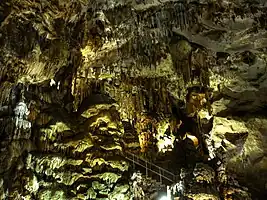Devetashka cave
Devetàshka cave (Bulgarian: Деветашката пещера) is a large karst cave around 7 km (4.3 mi) east of Letnitsa and 15 km (9.3 mi) northeast of Lovech, near the village of Devetaki on the east bank of the river Osam, in Bulgaria. The site has been continuously occupied by Paleo humans for tens of thousands of years, served as a shelter for various faunal species during extensive periods and is now home to nearly 30,000 bats.[1]
Деветашката пещера | |
 Bats and crag martins populate the site | |
 location in Bulgaria | |
| Alternative name | Devetetashka Site |
|---|---|
| Location | near Letnitsa and Lovech town |
| Region | Bulgaria |
| Coordinates | 43°14′11″N 24°53′44″E |
.JPG.webp)
Location
Devetashka cave is located approximately 2 km (1.2 mi) from the village of Devetaki. A narrow path by the river leads from the village to the cave. It can also be accessed directly via Road 301 along a 400 m (1,300 ft) long dirt road and a concrete bridge. Now part of a public park, that includes a waterfall, the 2 km (1.2 mi) long karst cave formed from the dissolution of soluble rocks, characterized by sinkholes and an underground river. It is rich in speleothems, stalagmites, stalactites, countless rivulets and majestic natural domes.[2]
The site is 35 m (115 ft) wide and 30 m (98 ft) high at the entrance. The cave widens after around 40 m (130 ft), forming a spacious hall with an area of 2,400 m2 (26,000 sq ft), a height of 60 m (200 ft) that can reach up to 100 m (330 ft). Several large openings in the ceiling allow daylight to lighten the vast interior, due to commercial use of the site during the 1950s.[3]
Rediscovered in 1921, excavations began only in the 1950s and revealed almost continuous human occupation since the late Paleolithic. Earliest traces of human presence date back to the Middle Paleolithic around 70,000 years ago. The site also contained one of the richest sources of Neolithic cultural artifacts (6,000 to 4,000 BC).[4]
Fauna
Besides significant archaeological findings, Devetashka cave provides a habitat for a wide diversity of faunal residents. During the breeding season of mammalian species in the cave from early June to the end of July, the site is entirely closed to visitors. Twelve species of protected amphibians and reptiles, including the Aesculapian snake (Zamenis longissimus), the Triturus (Triturus cristatus), the European tree frog (Hyla arborea), Hermann's tortoise (Testudo hermanni), eighty-two bird species can be found in the area, thirteen of which are included in the Red List. Thirty-four species of mammals, four of which are included in the Red List and fifteen species of bats are to be found at the Devetashka cave.[5]
Filming
Devetashka cave was shown in the action movie The Expendables 2, filmed in 2011. The Supreme Administrative Court of Bulgaria declared that several activities during filming violated Bulgaria's environmental regulations. A contractor hired by The Expendables crew was subsequently fined for trimming the shrubbery in front of the site.[6][7] After a fatal accident during the filming of a stunt, the production team again clashed with the authorities over damages to the cave. Loud noises, bright lights, crowds of people and fires in close proximity to the cave might have caused the displacement of large numbers of bats from the cave. However, by late 2012, the majority of the bats had returned to the cave.[1]
References
- "Bats in Bulgaria - Green Balkans". Greenbalkans.org. Retrieved January 24, 2017.
- "Lovech". britannica.com. Retrieved January 24, 2017.
- "devetashka cave". truebulgaria. Retrieved January 24, 2017.
- ". Pleistocene avian localities in Bulgaria". Retrieved January 24, 2017.
- "Are Bulgarian caves protected? - Life". Bnr.bg. Retrieved January 24, 2017.
- "'The Expendables 2' Fined For Damaging Protected Bat Habitat In Bulgaria". Deadline.com. Retrieved January 24, 2017.
- "Top Bulgarian Court Confirms Filming in Devetashka Cave Illegal – Caving News". Cavingnews.com. Retrieved January 24, 2017.
External links
 Media related to Devetashka cave at Wikimedia Commons
Media related to Devetashka cave at Wikimedia Commons- Devetashka Cave
